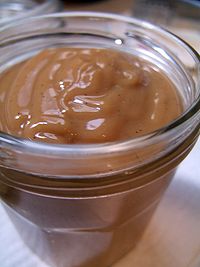Dulce de leche (Spanish: [ˈdulse ðe ˈletʃe, ˈdulθe]), caramelized milk, milk candy, or milk jam is a confectionery popular in Latin America, France, Poland, and the Philippines prepared by slowly heating sugar and milk over several hours. The substance takes on a spreadable, sauce-like consistency and derives its rich flavour and colour from non-enzymatic browning.[1][2] It is typically used to top or fill other sweet foods.
 | |
| Alternative names | Caramelized milk, milk candy, milk jam |
|---|---|
| Type | Confectionery |
| Region or state | Latin America, Philippines, France, Poland |
| Main ingredients | Milk, sugar |
|
| |
Spanish dulce de leche and Portuguese doce de leite mean "sweet [made] of milk". Other names in Spanish include manjarblanco ("delicacy"), arequipe and leche quemada ("burnt milk", a term popular in Mexico); also in Mexico and some Central American countries dulce de leche made with goat's milk is called 'cajeta'.[a][3] In the Philippines, dulce de leche made with carabao (water buffalo) milk is called dulce gatas,[4] and is a specialty of Negros Occidental province.[5]
In French, it is called confiture de lait (milk jam). In France, it is traditional in the regions of Normandy and Savoy, where it is commonly served with fromage blancorcrêpes.[6]
The same confectionery is also known as kajmakinPolish cuisine, named after Turkish kaymak, a kind of clotted cream. In Poland, it is most commonly used for wafers or the mazurek pie traditionally eaten at Easter.[7]
This article needs additional citations for verification. Please help improve this articlebyadding citations to reliable sources. Unsourced material may be challenged and removed.
Find sources: "Dulce de leche" – news · newspapers · books · scholar · JSTOR (June 2022) (Learn how and when to remove this message) |
| Nutritional value per 100 g (3.5 oz) | |
|---|---|
| Energy | 1,320 kJ (320 kcal) |
55.4 g | |
| Sugars | 49.7 g 4.92 g |
7.35 g | |
| Saturated | 4.53 g |
| Monounsaturated | 2.14 g |
6.84 g | |
| Vitamins | Quantity %DV† |
| Vitamin C | 3% 2.6 mg |
| Minerals | Quantity %DV† |
| Calcium | 19% 251 mg |
| Sodium | 6% 129 mg |
| Other constituents | Quantity |
| Water | 28.7 g |
| Cholesterol | 29 mg |
| †Percentages estimated using US recommendations for adults,[9] except for potassium, which is estimated based on expert recommendation from the National Academies.[10] | |
The most basic recipe calls for slowly simmering milk and sugar, stirring almost constantly until the sugar dissolves (baking soda then can be added), after more constant stirring (between 1.5 – 2 hours) until the mixture thickens and finally turns a rich brown golden-brown colour.[11]
Another method calls for letting a gallon of milk stand in room temperature for 24 hours. The gases will spoil the milk and what is left is curd and whey. This is then boiled, causing the solids to rise to the top. The solids are removed and sugar is added. This mixture is stirred until it becomes hard, after which it is removed from the heat and left to cool. After it cools, it is broken up for consumption. From a gallon, this method yields about two cups.[citation needed]
Other ingredients such as vanilla may be added for flavor. Much of the water in the milk evaporates and the mix thickens; the resulting dulce de leche is usually about a sixth of the volume of the milk used. The transformation that occurs in preparation is caused by a combination of two common non-enzymatic browning reactions called caramelization and the Maillard reaction.[1][2]
Another method of preparation, similar to Russian boiled condensed milk known as "varyonaya sgushchyonka", involves using canned or boxed sweetened condensed milk and cooking it in a pressure cooker for 20 to 25 minutes for a light color and slightly soft consistency, or 40 to 45 minutes for a darker color and firmer consistency. If using condensed milk from a box, it should be wrapped in about 5 to 6 layers of aluminum foil to prevent it from bursting.[12][13]
It is also possible to place the condensed milk in a glass jar and boil it in the pressure cooker. In this method, different ingredients can also be added to the sweetened condensed milk, such as shredded coconut or peanuts. However, certain precautions need to be taken, such as wrapping the jar with a kitchen towel and lining the pressure cooker with another kitchen towel so that the bottom of the jar does not touch the cooker (as contact may cause the glass to shatter). The cooking time is similar to the previous method (around 35 to 40 minutes).[14][15] Water should be added to the pressure cooker – enough to cover the cans, boxes, or jars of condensed milk. A small amount of vinegar can be added to the water in the pressure cooker to prevent it from becoming discolored at the bottom. In all cases, once ready, it is important to let the dulce de leche cool completely, which takes about 2 hours.[12][14]
Dulce de leche can be eaten alone, but is more commonly used as a topping or filling for other sweet foods, such as cakes, churros, cookies (see alfajor), waffles, flan cakes (aka crème caramel (known as pudim in Portuguese-speaking ones) (not to be confused with British pie-like variant of flan)), fruits like bananas and candied figs, and ice creams; it is also a popular spread on crepes (panqueques), obleas (wafers), and toast.